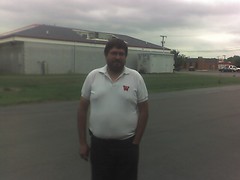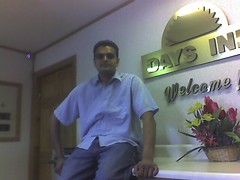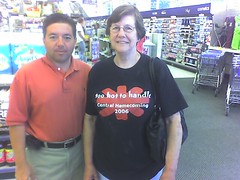 I woke up to raging, searing blisters. I could barely walk to the breakfast area, two doors down. While this is a walk, at an average of 24 miles per day it is more like a lengthy 'sprint!' As this walk, the stories I’ve been getting and its overall mission, was too important to jeopardize, this morning would have t
I woke up to raging, searing blisters. I could barely walk to the breakfast area, two doors down. While this is a walk, at an average of 24 miles per day it is more like a lengthy 'sprint!' As this walk, the stories I’ve been getting and its overall mission, was too important to jeopardize, this morning would have t o be a rest day (subtracting 15 miles from the total walk distance.) Besides, I don’t have health insurance and a major foot infection could not only knock me out of the walk (letting down many people) but also drive me into bankruptcy or worse. My “Living Will / Advance Directive” states that if I am incapacitated, I do not wish lifesaving measures to be taken. That’s the reality.
o be a rest day (subtracting 15 miles from the total walk distance.) Besides, I don’t have health insurance and a major foot infection could not only knock me out of the walk (letting down many people) but also drive me into bankruptcy or worse. My “Living Will / Advance Directive” states that if I am incapacitated, I do not wish lifesaving measures to be taken. That’s the reality.
So, I took a break in the morning (walking, though, every day) updating dispatches, sending emails, and doing other logistical matters. Besides a small rally was planned and I wanted to be ready for the long afternoon walk to follow. I had a chance to talk with some people at the Days Inn in Plymouth. Here are some of their stories.
 Jay: Jay is the manager of the hotel and he told me the story of his uncle who had a heart attack and required a triple bypass operation. Unfortunately he was uninsured and the operation would cost about $118,000. There was no way that he could pay that money—the money that would save (or at least extend) his life. And so he ended up having the operation in India which, with airfare, cost about $35,000. Jay (and his staff) were enormously gracious and generous (they provided a complimentary room) and when I told him of the difficulties of such a long walk and my blisters (thankfully, I’ve got no major tendinitis or other connective tissue issues) he told me “remember Ogan, slow and steady wins the race,”
Jay: Jay is the manager of the hotel and he told me the story of his uncle who had a heart attack and required a triple bypass operation. Unfortunately he was uninsured and the operation would cost about $118,000. There was no way that he could pay that money—the money that would save (or at least extend) his life. And so he ended up having the operation in India which, with airfare, cost about $35,000. Jay (and his staff) were enormously gracious and generous (they provided a complimentary room) and when I told him of the difficulties of such a long walk and my blisters (thankfully, I’ve got no major tendinitis or other connective tissue issues) he told me “remember Ogan, slow and steady wins the race,”
Mike: Mike’s the fiancé of the front desk attendant. He doesn’t have insurance having recently lost his job. “I still owe a bunch of doctor’s bills,” he told me. “I broke my hand and right now its better but I owe $12,000.”
And so that afternoon a bunch of us gathered—Cassie, Mike, and Keith and we headed the two miles downtown and back. We talked about life in Plymouth, all the people losing jobs and many stories of others who had lost insurance and experienced a whole set of healthcare woes.

 We saw some interesting sites in Plymouth. Apparently, one can buy artillery shells there! After returning to the hotel, and feeling better (though distressed, of course, at all the hardship I’ve learned of), I walked another five miles to bulk up my miles. During that walk I went to dinner (Burger King) and stopped at a Walgreen’s to buy seven tubes of Neosporin and other supplies, preparing for a night of ‘minor surgery.” At the store, I met two women who shared with me their stories.
We saw some interesting sites in Plymouth. Apparently, one can buy artillery shells there! After returning to the hotel, and feeling better (though distressed, of course, at all the hardship I’ve learned of), I walked another five miles to bulk up my miles. During that walk I went to dinner (Burger King) and stopped at a Walgreen’s to buy seven tubes of Neosporin and other supplies, preparing for a night of ‘minor surgery.” At the store, I met two women who shared with me their stories.
Val: Val is 58. She told me, “She and her husband have worked all their life, had insurance all their life and were both laid off in November. We’re both looking for jobs and have had no health insurance for the first time. We’re too young for Medicare. We don’t know what we’ll do.”
 Ginny: Ginny lost work and took early retirement at 62 but, she told me, “The bad thing about that is that there’s no health insurance.” I nodded. “I make too much for the Indiana health care program, but not enough to pay for medial insurance. It costs at least $300 a month. I’ve got diabetes and high blood pressure and five grandchildren that live with me. My daughter is legally blind so if something happens to me, I don’t know what will happen, who will care for, the children.” Perhaps that explains why I look pretty grim in the picture. I'm inspired, and humbled, by the bravery of regular, hardworking Americans.
Ginny: Ginny lost work and took early retirement at 62 but, she told me, “The bad thing about that is that there’s no health insurance.” I nodded. “I make too much for the Indiana health care program, but not enough to pay for medial insurance. It costs at least $300 a month. I’ve got diabetes and high blood pressure and five grandchildren that live with me. My daughter is legally blind so if something happens to me, I don’t know what will happen, who will care for, the children.” Perhaps that explains why I look pretty grim in the picture. I'm inspired, and humbled, by the bravery of regular, hardworking Americans.
With pain from head to toe (in my mind from hearing these stories and down below in my feet from blisters), it’s difficult to keep walking. But I did and, thankfully, I am here to bear witness to what is becoming increasingly apparent to me as a national catastrophe of epic proportions. This must change.
© 2009, Ogan Gurel, MD
ogan@walk4healthcare.org













